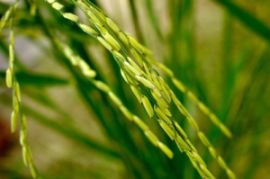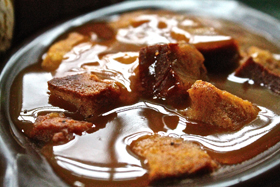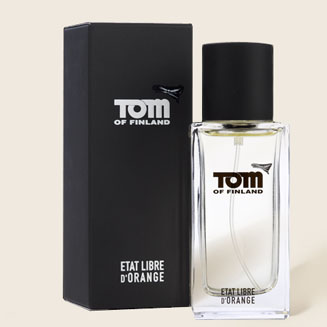He brings the sun.
 Bringing the warm joyousness of the sun by way of a perfumed ode to the Asian tropics — an ode that sparkles with the very brightest of zingy, crisp citruses; that luxuriates in the creamy sweetness of sticky coconut Thai rice; and that strokes you with the velvety headiness of jasmine, before turning into a soft, golden, amber embrace. That is the journey offered by Fils de Dieu, a unisex eau de parfum from the whimsical, playfully avant-garde, often satirical, always provocative French perfume house, État Libre d’Orange (hereinafter just “État Libre“). The perfume’s full name is actually Fils de Dieu, Du Riz et Des Agrumes which means “Son of God, of Rice and of Citruses” and, to make matters a little more confusing, used to be called Philippine Houseboy. (Terrible name! Thank God for the change.)
Bringing the warm joyousness of the sun by way of a perfumed ode to the Asian tropics — an ode that sparkles with the very brightest of zingy, crisp citruses; that luxuriates in the creamy sweetness of sticky coconut Thai rice; and that strokes you with the velvety headiness of jasmine, before turning into a soft, golden, amber embrace. That is the journey offered by Fils de Dieu, a unisex eau de parfum from the whimsical, playfully avant-garde, often satirical, always provocative French perfume house, État Libre d’Orange (hereinafter just “État Libre“). The perfume’s full name is actually Fils de Dieu, Du Riz et Des Agrumes which means “Son of God, of Rice and of Citruses” and, to make matters a little more confusing, used to be called Philippine Houseboy. (Terrible name! Thank God for the change.)
Fils de Dieu was created by Ralf Schweiger, and was released in 2012 to much acclaim, landing in the Top Five of CaFleureBon‘s Best Perfumes of 2012 list. The perfume veers far outside the parameters of my usual style or preferences, but I actually like it and think it would be a great, easy, casual summer scent.
État Libre describes Fils de Dieu and its notes as follows:
He brings the sun.
Fils de dieu comes from the Philippines to spread a message of warmth and enlightenment. Here, find an innocent wisdom that points to dreams and liberation. This is the golden eye that reflects beauty and conflict, rapture and pain. Fils de dieu is an emotional fragrance, a scent that requires a sympathetic connection between the server and the served, the giver and the taker, and the willingness to exchange roles.
Composition : Ginger, coriander leaves, lime, shiso, coconut JE, rice, cardamom JE, jasmine, cinnamon, may rose, tonka bean, vetiver, musk, amber, leather, castoreum…
I have no idea what “JE” stands for, but let’s move on. What caught my attention with Fils de Dieu is how it can be many different fragrances in one. I tested it twice — once in chilly, air-conditioned temperatures, and once in muggy warmth. The first time, and with the impact of the cold, I noticed Fils de Dieu had three, distinctly separate stages that can be summed up essentially as follows:
Stage One: Almost all crisp, aromatic citrus cologne notes – about 90% citrus, 8% lemongrass-y vetiver, and 2% jasmine;
Stage Two: Primarily jasmine in nature – about 75% jasmine, 15% citrus, 5% lemongrass-y vetiver, and 5% other notes;
Stage Three: A whole other perfume — fluctuating levels of vanilla and amber for the most part, followed by spices, a dash of castoreum, and flickers of other elements.
Yet, it was an entirely different matter when I turned off the air-conditioning (which was a painful experience given where I live), and let the tropical humidity do its work. In the sort of thick, wet air that must resemble Fils de Dieu’s Philippine inspiration, the perfume bloomed to become the sort of scent it was clearly intended to be: a slightly sweet ode to Thai food, interspersed with exotic, tropical, heady jasmine, custardy vanilla, citrus, spices, and sensuous warmth.
THE FIRST TEST:
Let’s start with the first test, where Fils de Dieu bewildered me by being a crisp, citrus cologne for the entirety of its opening. The perfume starts on my skin with fresh shiso that smells minty, just lightly peppery, and incredibly fresh. Within seconds, it is joined by zesty lime and bergamot, both shining brightly with an almost translucent radiance.
Fils de Dieu quickly softens, with the citrus notes fading to slightly more muted levels, and flecked with a bright rose tonality, along with the merest hint of airy jasmine. Then, the citrus comes back, stronger and heartier than ever, only this time headed up by bergamot. As always, its main companion is the lime, which feels a wee bit bitter now. Rounding out the top three notes is vetiver which has a very lemongrass-like nuance here, instead of its more common, rooty, dark, or earthy characteristics. Five minutes later, a rice note creeps in. It’s milky, barely sweetened, and evocative of boiled jasmine. The note is so insubstantial, however, that it really takes vociferous inhalations to detect it for the brief moments that it’s there.
For the next 90 minutes, Fils de Dieu is nothing more than a masculine sort of cologne on my skin. It’s citrus, more citrus, a dash of vetiver, a few drops of jasmine, and that mysteriously vanishing rice note. There is a minute, tiny, faint hum of synthetics at the base — something I’ve noticed in all Ralf Schweiger’s fragrances to varying degrees — but there are no spices, no vanilla, and absolutely no coconut whatsoever. I actually felt a little cheated, given all that I’d heard about Fils de Dieu’s supposed resemblance to Thai Curry. Well, not on me, at least not under chilly temperatures… Over time, the strength of the main notes varies (and, sometimes, the jasmine feels much more dominant), but, ultimately, there is no escaping the citruses and the cologne impression.
Then, 2.25 hours in, Fils de Dieu changes. Parts of my arm now emit faint traces of really sweet, boiled rice infused with jasmine; another part wafts jasmine with amber and a touch of castoreum; and a third (much smaller) part is simply nothing more than lemongrass vetiver and cool lime. It’s bewildering. Clearly, Fils de Dieu is a beautifully blended, well-crafted fragrance that reflects different notes at different times. But, for the majority of this test, it was “fragrant” in the most aromatic sense of the word, as something that was primarily citrus and jasmine in nature.

Salted Caramel & Nutella Rice Krispie Treats. Source: The Mini Baker. (Click on photo for link to website and the recipe.)
The slow progression of the scent continues, morphing slowly into its third and final phase. Around the third hour, Fils de Dieu turns into jasmine fragrance with a sweet, dry vanilla that has a lightly perfumed finish and the merest hint of cinnamon. At the four-hour mark, however, the perfume has a complete metamorphosis, turning into an ambery butterfly with an almost boozy edge. It’s plush, nutty, infused with cardamon and cinnamon, and has a distinctly toffee undertone. The rice note pops up again, but this time it’s toasted; it smells a little like Rice Krispies would — if they were covered by toffee, cinnamon and amber.
The amber is beautiful here, with the sort of rich depth that you’d normally find in ambergris — but without the salty, marshy, slightly sweaty characteristics of the element. I chalk the rich depth of the note to the castoreum which definitely accounts for the subtle tinge of sweet musk lurking around Fils de Dieu’s edges. Underneath the amber is the lightest suggestion of leather that feels very smooth, supple, warm, as if it had been burnished by sweet resins. There is no longer any vanilla to distract from all the gold, bronze, umber visuals. As time passes, the perfume continued to soften and the notes turn more abstract.
A little short of 8.25 hours in, Fils de Dieu finally fades away, nothing more than musky, ambered sweetness. Its sillage was moderate at the start, continued to drop after the first hour, and then faded away to a skin scent around the middle of the fifth hour. The truly astonishing thing, though, is the degree of change. Between the spices, the languorous, castoreum-infused resins, the sweetness, and the plush richness of the scent, Fils de Dieu did a complete 180 from its opening as a crisp, citrus cologne. You couldn’t get a more drastic change — which is why I decided I needed to test the perfume under very different conditions.
SECOND TEST:
For my second test, I turned off the air-conditioning, opened the windows, and let the humidity of the muggy swamp outside invade my office. The heat wave has left, so the difference in internal temperature according to the thermostat only seems to be about 16 degrees, but the humidity is easily close to 90%. And what a difference that made to Fils de Dieu! It suddenly turned into the fragrance that it was supposed to be.
Once again, Fils de Dieu opens as a citrus scent with the brightest of green notes. There is shiso leaf with its lightly peppered, minty aroma, followed by lemon and bergamot – both as airy, fresh and bright as a blade of grass. A quiet sweetness soon infuses the notes, turning them into something warmer, richer, and less crisp. Hints of vetiver, still with a lemongrass nuance, creep in. So do the lightest hints of vanilla and ginger (something I never detected at all in my first test).
But then, it all changes, and far more quickly than it did the first time around. No less than twenty-five minutes into the perfume’s development, Fils de Dieu turns into a scent that is primarily sweet rice boiled in coconut cream and sprinkled by a light veil of jasmine! The bergamot, lime, and light green herbs are still there, but they are mere seasoning to accentuate the main dish.
The rice note is strong, sweet and lactonic, infused by coconut that feels, simultaneously, both like the light, delicate milk, and the richer, buttery cream. At the same time, there is a strong flutter of lemon-tinged coriander leaves at the back; the ginger feels slightly sweetened; and the vanilla takes on an eggy, custard richness that’s speckled with lime. Good heavens, what a sharp contrast! Fils de Dieu remains that way for hours and hours, fluctuating only in the degree of some of its notes, but never changing its primary essence. On occasion, cinnamon will make a small appearance, but that’s about the only difference.

Coconut Lime Rice Pudding Brulee via Becks & Posh blogspot. (Click on photo for the recipe and website link.)
Then, around the end of the fourth hour, there are changes. The rice note goes from milky sweet to something that is toasted and, again, strongly calls to mind Rice Krispies. It is covered with a light toffee and with a vanilla note that is still custardy but, now, it also has a powdery aspect to it. All the notes sit atop a base of plush amber that has been enriched by the warm, light, musky, velvety aspects of castoreum, along with cardamom and cinnamon. It’s all very muted, light, soft and very sheer — and quite a contrast to the rich, heavier, deeper base of Fils de Dieu during the cold temperature test.
Clearly, the humidity sucked all the richness out of the amber marrow because the drydown never reached the same depths with the heat. Starting in the sixth hour, the perfume feels more like simple, generic, uninteresting amber with some sweetness and musk. In its final moments during the second test, as in the first, Fils de Dieu was just sweet muskiness, and nothing more. Oddly enough, the heat seemed to extend the lifespan of the scent which lasted 11.25 hours on my skin, instead of 8.25. I can’t quite understand it because it seems like it should be the reverse, unless the heat just makes the musk bloom. As for the sillage, it was even softer than usual with the heat.
OVERALL:
The differences in the test show something beyond just the impact of climate. They demonstrate just how well-blended the fragrance can be, throwing off different notes under different conditions. In all cases, however, the perfume didn’t feel wholly and completely gourmand in nature, despite the foodie resemblance to certain Asian dishes. The simple reason is that Fils de Dieu isn’t massively sweet; the citrus elements help ensure it never verges on the cloying and keep an element of freshness about the scent. And it really is a very fragrant one, in the best sense of the word.
Is Fils de Dieu revolutionary, edgy, and funky? Absolutely not! Is it cozy, comforting, incredibly easy to wear? Definitely. I don’t know how often one would normally want to smell like Fils de Dieu’s more rice-centered notes, but I think the perfume’s different personalities give one some options. Its more zesty, aromatic, citrus freshness in cold temperatures makes me think that those who want to avoid a “foodie” scent can use it in cooler weather, while those who enjoy the sweetly lactonic, rice and jasmine aspect can opt for the summer months to let it really bloom.
There seems to be quite a bit of love for Fils de Dieu in the perfume community, but there are also plenty of people who don’t find it all that interesting. For example, Now Smell This was distinctly unimpressed, with Kevin writing:
Fils de Dieu opens with gingery lime, and “green” coriander and pungent shiso leaf. As the sprightly opening notes begin to disappear (and they disappear fast), the scent of “nutty” coconut makes a brief appearance and then…? Fils de Dieu begins to disappear. Was that IT?
Fils de Dieu is one of those scents that falters and then makes a comeback. After the opening fizzles, the comeback notes are mild jasmine, hazy vetiver, dry, tonka bean-scented rice (to my nose, this is more a toasted rice note, not steamed rice or rice pudding) and…leather (the most “background,” powdery, see-thru leather note you can imagine). Fils de Dieu’s rose note is very mild; it disappeared quickly on my skin, but I could detect it on my shirt for hours. Fils de Dieu’s base notes smell of shamefaced musk (certainly not the bold castoreum I was expecting) mingling with a light amber-y accord. […][¶]
Fils de Dieu is only semi-tropical and, for me, doesn’t conjure a houseboy, a sunny god, or the Philippines (or any Southeast Asian locale). Fils de Dieu does remind me of old-style, lightly spiced white floral feminine French perfumes from long ago.
I wonder if he tried it with the air-conditioning on? Like him, I smelled nothing tropical in my first test either, though I did have that wonderful drydown with the chilly temperature which seems infinitely better than what he got. Oddly, CaFleureBon‘s experience seems to be a mixture of both of mine together:
The Asian vibe is accentuated right from the top notes of Fils de Dieu as a tart lime and smooth shiso leave no doubt about what part of the world your nose is located in. Ginger and coconut join in to add a tropical facet to the early going. The shiso and the coconut really are the stars in the top notes. M Schwieger chooses only one floral note for Fils de Dieu; jasmine. He surrounds the jasmine with a steamed rice accord and a spicy duo of cardamom and cinnamon. The rice accord is beautifully realized and M Schwieger uses it to add a palpable humidity to the heart of Fils de Dieu. The base notes are animalic but kept exquisitely balanced and well controlled. Leather, musk, and castoreum create a slightly sexual accord over a healthy foundation of vetiver and amber.
Over on Basenotes, the tropics and food also seem to be the main conclusions of the day — but few consider Fils de Dieu to be as nuanced or as good as CaFleureBon did. Most of the commentators talk about Thai food or curries, though one found Fils de Dieu to be primarily citruses and vanilla that turned a little coconut-y at the end to create an average, spicy oriental that, in his opinion, veered sharply from État Libre’s best. Food — and rice, in specific — are also the focus at Fragrantica where, unlike at Basenotes, the posters generally seem to adore Fils de Dieu. One commentator found the fragrance to be primarily jasmine and vanilla, but the majority experienced the full complement of notes, with a number talking about the rich, musky, amber drydown.
I don’t like very foodie scents and I cannot abide anything gourmand, but I would wear Fils de Dieu. Granted, not all that often, but it’s an easy, uncomplicated comfort scent in my opinion, and I enjoyed different parts of each of its split personalities. For me, the sweet, heady jasmine and the zesty, fresh citruses prevent the fragrance from verging too heavily into either problematic category. Once Fils de Dieu loses its purely shiso-lime-bergamot facade, the overall bouquet keeps you coming back for one more sniff. Plus, it’s thankfully not sweet enough to be a true dessert scent. And, it’s very affordable, too! That said, I would not recommend Fils de Dieu to someone who dislikes even minor foodie elements in their perfume, nor to someone looking for a highly complex, sophisticated scent. Also, I think that a man who doesn’t like sweeter floral fragrances may find Fils de Dieu to be a little feminine in nature, despite the citrus top notes. But if you’re looking for a casual, cozy, sunny fragrance, give Fils de Dieu a try. You just may want to turn decrease the air-conditioning when you do so….




















 Many people have complained that État Libre d’Orange Tom of Finland lacks roughness, toughness and any hint of male “body aromas” one would imagine emanating from a Tom of Finland-type man, but to me, the Tom of Finland man, like the fragrance, is clean (almost wholesome), wrinkle-free/smooth, and pale. For those who bemoan the lack of funk in this version, perhaps a Tom of Finland “rough seXXX” flanker will be forthcoming. [Emphasis added.]
Many people have complained that État Libre d’Orange Tom of Finland lacks roughness, toughness and any hint of male “body aromas” one would imagine emanating from a Tom of Finland-type man, but to me, the Tom of Finland man, like the fragrance, is clean (almost wholesome), wrinkle-free/smooth, and pale. For those who bemoan the lack of funk in this version, perhaps a Tom of Finland “rough seXXX” flanker will be forthcoming. [Emphasis added.]